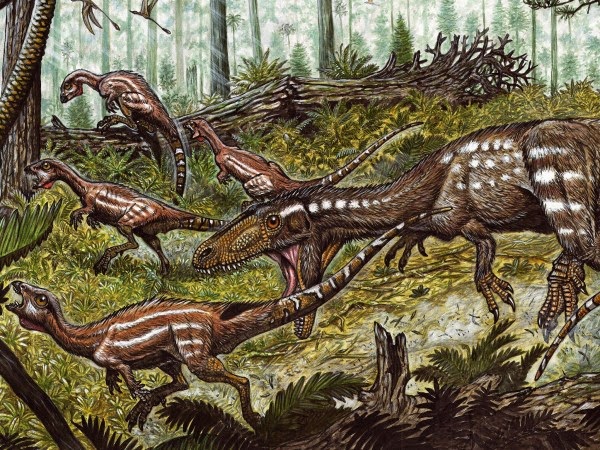
A newly described dinosaur, whose fossils are some of the first to be unearthed in Venezuela, turns out to be the close, relatively small kin of creatures that later evolved into multiton meat eaters such as Allosaurus and Tyrannosaurus rex. The creature, and another dinosaur whose fossils were found nearby and reported just 2 months ago, are filling in gaps in the fossil record and revealing new insights into dinosaur evolution in the wake of a mass extinction that happened about 201 million years ago.
The new species, dubbed Tachiraptor admirabilis, is a predator that gets part of its name from the Venezuelan state of Táchira, where the fossils were found. Only two bones of the ancient species have been unearthed, says Max Langer, a vertebrate paleontologist at the University of São Paulo in Brazil. Nevertheless, those bits (each from a different individual, and one of them not even a complete bone) tell scientists a lot, Langer notes.
The bones, both from the creature’s lower leg, show the dinosaur likely measured about 1.5 meters from nose to tail, Langer says. Their general size and shape mark the creature as a theropod, a bipedal meat eater. The bones differ enough from those of other theropods to indicate that the dino is a new species, Langer and his colleagues report today in Royal Society Open Science.
The now-solid rocks surrounding the fossils, which were laid down as sediments on an ancient flood plain, also tell a story. By age dating zircons—tiny crystals that typically include uranium as a trace element—in the rocks, Langer and his colleagues estimate that the sediments were deposited about 200.7 million years ago. At that time, the region—a volcanically active rift valley where Gondwana, a remnant of the supercontinent Pangaea, was itself splitting apart—sat near Earth’s equator. The period was also less than 1 million years after the mass extinction that marked the end of the Triassic period and the beginning of the Jurassic—an event that, like the dino die-offs that occurred about 65 million years ago, may have been triggered by an extraterrestrial impact.
“These survivors of the Triassic-Jurassic mass extinction were the ‘ground zero’ for later theropod evolution,” says Thomas Holtz Jr., a vertebrate paleontologist at the University of Maryland, College Park, who was not involved in the study. Plus, he notes, theropod fossils from this era from anywhere in the world aren’t common, so the new finds reveal what some theropods of that era looked like and will be particularly useful to researchers trying to flesh out the dinosaur family tree. The new study, he says, “shows that important discoveries don’t have to be of the biggest or the scariest [dinosaurs].”
The first dinosaur reported from this region, which lived in the same area and at the same time as Tachiraptor, was unveiled in August. That creature, dubbed Laquintasaura, was slightly smaller than Tachiraptor but had the same general appearance despite being a member of a different group of dinosaurs called ornithischians, says Richard Butler, a vertebrate paleontologist at the University of Birmingham in the United Kingdom and a member of the team that described Laquintasaura. “All the small dinosaurs of that era looked about the same,” he notes, but subtle skeletal differences help distinguish the carnivorous theropods from their herbivorous and omnivorous relatives.
The last common ancestor of theropods and ornithischians, a creature as-yet undiscovered, probably looked a lot like Tachiraptor and Laquintasaura, Butler says. Only millions of years later did many species within these groups evolve great size and distinct appearances, he notes.
More fossils from this region could help paleontologists refine the dinosaur family tree further, Langer says. But such work may be a long slog, he suggests, because rocks that might hold fossils aren’t readily accessible: The recent discoveries, which were unearthed at sites where highway excavations sliced through heavily vegetated hillsides, came only after 2 decades of looking for such fossils.
Note : The above story is based on materials provided by American Association for the Advancement of Science. The original article was written by Sid Perkins.










